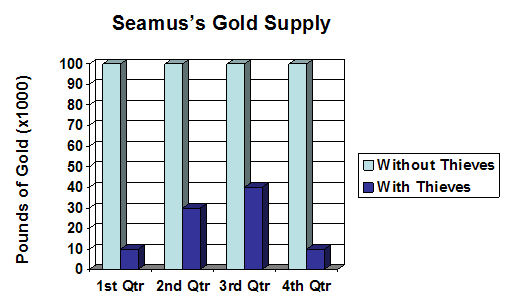
advertisement
Hotel Managers – Would you rather be Lucky or Good?
The Orgwide Problem Solving Process beats a 4 leafed clover every time!
|
News for the Hospitality Executive |

advertisement
Hotel Managers – Would you rather be Lucky or Good?
| By Jim Hartigan March 16, 2011 I’ve got this buddy, who, like me, used to be in the hotel business. In fact, this buddy of mine (for this discussion, let’s call him “Seamus”) owned a number of hotels and made a pot of gold flipping them back in the day. Today, he owns a business about 20 miles outside of Dublin, as the crow flies. Seamus is an auburn haired lad of somewhat diminutive stature (shorter than I am!) who is a hard-working, savvy entrepreneur. Despite all of these fine qualities, Seamus has a very serious business problem—he loses money at an alarming rate this time of year. “What kind of business does Seamus own?” you may be wondering. One might say Seamus works in the “financial” industry—he runs a “bank” of sorts with the proceeds from his previous hotel holdings. Seamus’s fiscal year starts on March 17th (St. Patrick’s Day, of course) and, as I mentioned, his challenge is that he always has difficulty protecting his assets from theft around that time. Well, just the other day, Seamus and I are enjoying a room-temperature stout at our local pub and he’s bemoaning his business woes ad nauseum. It was literally 30 minutes of “they always stealin’ me pot ‘o gold!” I finally had to cut him off. I looked at Seamus and I says to him, I says “Seamus—you’ve gotta do something about this problem you’re having. Have you heard of the ‘Orgwide Problem Solving Process’?” Well, of course, he hadn’t, or else I wouldn’t be telling you this story. Let me tell you, Seamus nearly fell off his wee barstool as I described the Orgwide Problem Solving Process, known as O3 to us insiders, which, as your luck would have it, I will now share with you. In a nutshell, O3 refers to the creation of a one page visual (drawing, charts, graphs, words, etc.) depicting a seven step problem solving process. The steps of that process are:
Background The Background step describes why you are even working on this issue, in a short (no disrespect to Seamus intended) simple phrase. Elements of the background step include a business case, reason, need, or issue; identification of the specific target audience; and a focus on the issue rather than potential solutions. Let’s quickly examine the background of Seamus’s problem as an example. His background statement might be something along the lines of “I am working on this issue because everyone’s after me pot ‘o gold and I’ll soon be bankrupt if I don’t find a solution.” Current Conditions The Current Conditions step is meant to describe what the current state of affairs is today in a way that the reader will understand. Elements of the Current Conditions step generally include visuals to help clarify the issue, including charts, graphs, and drawings. These statements and visuals should use quantitative measures rather than opinions to describe the problem. Seamus might use a graphic such as the one below to demonstrate the current conditions of his business.  Goals/Targets The purpose of the Goals/Targets step is to outline the desired state of affairs and describe how you will evaluate success. Elements of the Goals/Targets step will generally include numerical targets, precise measures of performance, and proposed data collection and reporting procedures. In order to demonstrate his desired state of affairs, Seamus might make the following chart:  Analysis The next step of the O3 process is Analysis. The purpose of this step is to describe the data gathered from research and investigate the likely root causes of the problem. The root cause analysis involves asking a lot of questions - specifically, a lot of “whys.” When thinking about potential root causes for your problem, you may find that asking “why” five times (or more) is required before you uncover the source of your problems. Additionally, during the Analysis phase, you must separate symptoms from cause and effect. Here’s a sample of our analysis of Seamus’s issue: Seamus: “They always stealin’ me pot ‘o gold!” Me: “Why?” Seamus: “Because they want to be rich!” Me: “Why?” Seamus: “So they don’t have to work anymore! Or because they’re already unemployed!” Me: “Why?” Seamus: “Because the global economy is in shambles, man! Don’t you watch the news? And why do you keep asking me ‘why’? You sound like a wee child!” Me: “Why?” Seamus: “SHUT IT!” Me: “Why?” Seamus: “THAT’S IT!” <Fisticuffs ensue> Okay, so the process broke down rather quickly in that example, but hopefully it helps to demonstrate that you must look below the surface (5 layers or more) before you fully grasp the root of your problem. After our little dustup, Seamus and I returned to the “five whys” and identified the root cause for his problem as a lack of security. Proposed Countermeasures The fifth step of the O3 process is Proposed Countermeasures. Your proposed countermeasures should illustrate potential actions that will improve current conditions and achieve stated goals. It is suggest to develop anywhere from 3-5 possible courses of action, address root causes, and remain neutral and objective. Recognizing Seamus’ root cause of Lack of Security, we developed these proposed countermeasures:
Plan
It’s finally time to implement your plan based on all of the data you’ve gathered during the previous 5 steps. Your plan should provide clear and unambiguous steps to implement your countermeasures. It should include the “who, what, and when”; identify dependencies and sequence of events; and monitor and assess progress. Here’s a look at an outline of Seamus’s final plan:  Follow-up The final step of O3 is Follow-up. Follow-up is meant to describe the effectiveness of the implemented countermeasure(s). Follow-up should use actual data to describe outcomes, identify potential post-implementation refinements, and identify opportunities to apply the learning on a larger scale. The Follow-up step permits the opportunity to engage in the 3 R’s – Review, Refine, and Redeploy. I’m happy to report that Seamus, after carefully considering each step of the O3 process, has reduced theft by 90% and increased his profits by nearly 80% in just one year. And, after paying particular attention to the Follow-up phase, Seamus has implemented his plan at each and every one of his “branches” and at his main gold reserve in Dublin. The Orgwide Problem Solving Process, O3, has proven itself to be a powerful tool for problem-solving, process improvement, and just getting stuff done in hotels as well as other types of business as well. As a firm believer that it’s “better to be good than lucky”, I hope this introduction to O3 will help you approach any current or future business problems you face at your hotel with more confidence than that four leafed clover you’ve been carrying around! Until next time, remember to take care of your customers, take care of each other, and take care of yourself!  About the Author: Jim Hartigan, Chief Business Development Officer and Partner joined OrgWide Services, a Training/e-Learning, Communications, Surveys and Consulting firm in April 2010 after nearly 30 years experience in the hospitality industry, including the last 18 as a senior executive with Hilton Worldwide. Jim’s last position was that of Senior Vice President – Global Brand Services where he provided strategic leadership and business development and support to the $22B enterprise of 10 brands and more than 3,400 hotels in 80 countries around the world. His team was responsible for ensuring excellence in system product quality, customer satisfaction, market research, brand management, media planning, and sustainability. |
| Contact: Jim Hartigan Chief Business Development Officer & Partner OrgWide Services 165 N. Main Street, Suite 202 Collierville, TN 38017 office: 901.850.8190 Ext. 230 mobile: 901.628.6586 [email protected] www.orgwide.com |